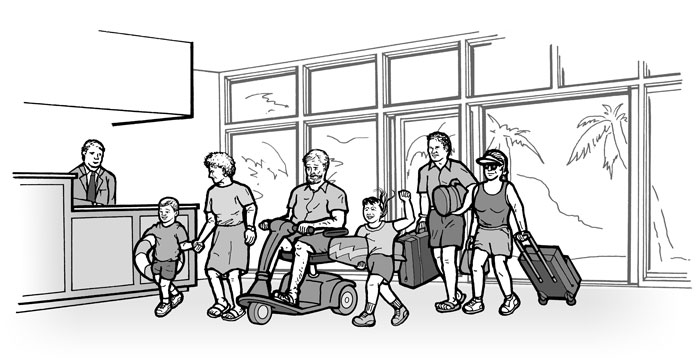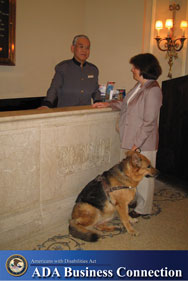|
Customer Service Issues for People with Disabilities
Poor customer service can ruin the stay of a guest with disabilities, even if the hotel facility itself is fully accessible. Here are a few examples of ways hotels and lodging establishments can turn guests with disabilities into satisfied, repeat customers.

Reservations
Staff working in central reservations as well as in individual hotel reservations offices need to know and be able to accurately inform potential guests about the accessible features offered in each of their facilities. Understanding what constitutes an accessible feature and how each feature serves guests with disabilities will enable staff to provide essential information to customers. Correctly answering a reservation inquiry about a hotel’s accessible features helps avoid an awkward or unsolvable situation when the guest with a disability cannot use the room that was reserved.
Once an accessible room is guaranteed to a prospective guest with a disability, an accessible room must be available to him or her upon arrival at the hotel. If an unexpected problem occurs that makes it impossible for the hotel to provide the accessible room promised, the hotel should make every reasonable effort to locate a comparable accessible room in the hotel or in another local establishment and cover cost differences, if they occur.
Communication
Hotel team members who have direct contact with guests should be prepared and ready to communicate with customers with disabilities. When telephone calls are received from a deaf person using a TTY or relay service, the call should be answered promptly and appropriately. When a guest with a disability arrives, hotel staff should talk to the customer with a disability rather than to her companion. Front-line employees must be informed and attentive to details related to guests with disabilities.
Maintaining Accessible Features for Customers
Attention to detail also plays a major role in maintaining a hotel’s accessible features. Sidewalks blocked by large trash receptacles, lowered reception desk areas filled with decorative vases, routes to public restrooms blocked by supplies, and poorly placed, oversized furniture in accessible rooms all convey to the customer with a disability a lack of understanding about accessibility. Hospitality is not provided when a guest cannot get to the front door, register at the front desk, eat in the restaurant, or maneuver around his room.
Without training, housekeeping staff and bellmen can unwittingly
compromise the best intentions to provide access. For example, if an
employee places the television remote control atop a tall chest of
drawers or leaves the adjustable shower head at the highest position,
then a guest who uses a wheelchair cannot reach them. If the
housekeeping staff adjusts the thermostat or opens the guest room
curtains during a post-arrival room cleaning, a guest who is blind may
be left in an uncomfortable and possibly embarrassing circumstance.
With instruction and consistent service, employees can maintain accessible
features and raise the level of a hotel’s guest satisfaction
rating.
Trends that Enhance or Hinder Accessibility
Trends in hotel decor and service can limit access: popular large
furniture, such as armoires, may take up valuable maneuvering space
in accessible rooms, and plush, pillow-top mattresses may make beds
too high to transfer to from a wheelchair. A platform bed precludes the
use of a personal lift in an accessible room. A hotel restaurant that
creates ambience with low lighting can make travel to a table difficult for an older customer; while a restaurant menu with a crisp, high
contrast contemporary design will make it easier to read for that same
guest. It is essential to understand the positive and negative effects of
trends on service to all customers, including customers with
disabilities.
Good customer service practices that assist people with
disabilities will bring repeat business from guests with
disabilities, older travelers, and friends and families that
accompany this large and growing market.
For more information about the ADA and business, visit the Department of Justice ADA Business Connection at www.ada.gov. Or, call the toll-free ADA Information Line:
800-514-0301 (voice) or 833-610-1264 (TTY)
References
Expanding Your Market: Accessible Customer Service Practices for Hotel and Lodging Guest with Disabilities (PDF version)
|
References
1. Erica Steinmetz, “Americans with Disabilities: 2002 Household Economic Studies.” U.S. Census Bureau,
http:// www.census.gov/prod/2006pubs/p70-107.pdf.
2. Roberto R. Ramirez and G. Patricia de la Cruz, “The Hispanic Population in the United States: March 2002 Population Characteristics.” U.S. Census Bureau, http://www.census.gov/prod/ 2003pubs/p20-545.pdf.
3. Open Doors Organization, Research Among Adults with Disabilities: Travel and Hospitality, prepared by Harris Interactive (Chicago: Open Doors Organization, 2005), 15.
4. Open Doors Organization, “2002 Market Study.” Open Doors Organization,
http://www.opendoorsnfp.org/_wsn/page3.html.
5. Yvonne J. Gist and Lisa I. Hetzel, “We the People: Aging in the United States Census 2000 Special Reports.” U.S. Census Bureau, http://www.census. gov/prod/2004pubs/censr-19.pdf.
6. Wan He, Manisha Sengupta, Victoria A. Velkoff, and Kimberly A. DeBaros, “65+ in the United States: 2005 Current Population Reports Special Studies.” U.S. Census Bureau, http://www.census. gov/prod/2006pubs/p23-209.pdf.
7. William D. Novelli, “How Aging Boomers Will Impact American Business.” Speech given at meeting of The Wisemen, The Harvard Club, New York, NY, February 21, 2002,
http:// www.aarp.org/about_aarp_leadership/ on_issues/baby_boomers/how_aging_ boomers_impact_business.html.
8. Deloitte Research, “Wealth with Wisdom: Serving the Needs of Aging Consumers.” Deloitte,
http://www. deloitte.com/dtt/cda/doc/content/ ca_cb_Aging%20Consumer_april_ 06.pdf.
last updated April 6, 2009
| 


